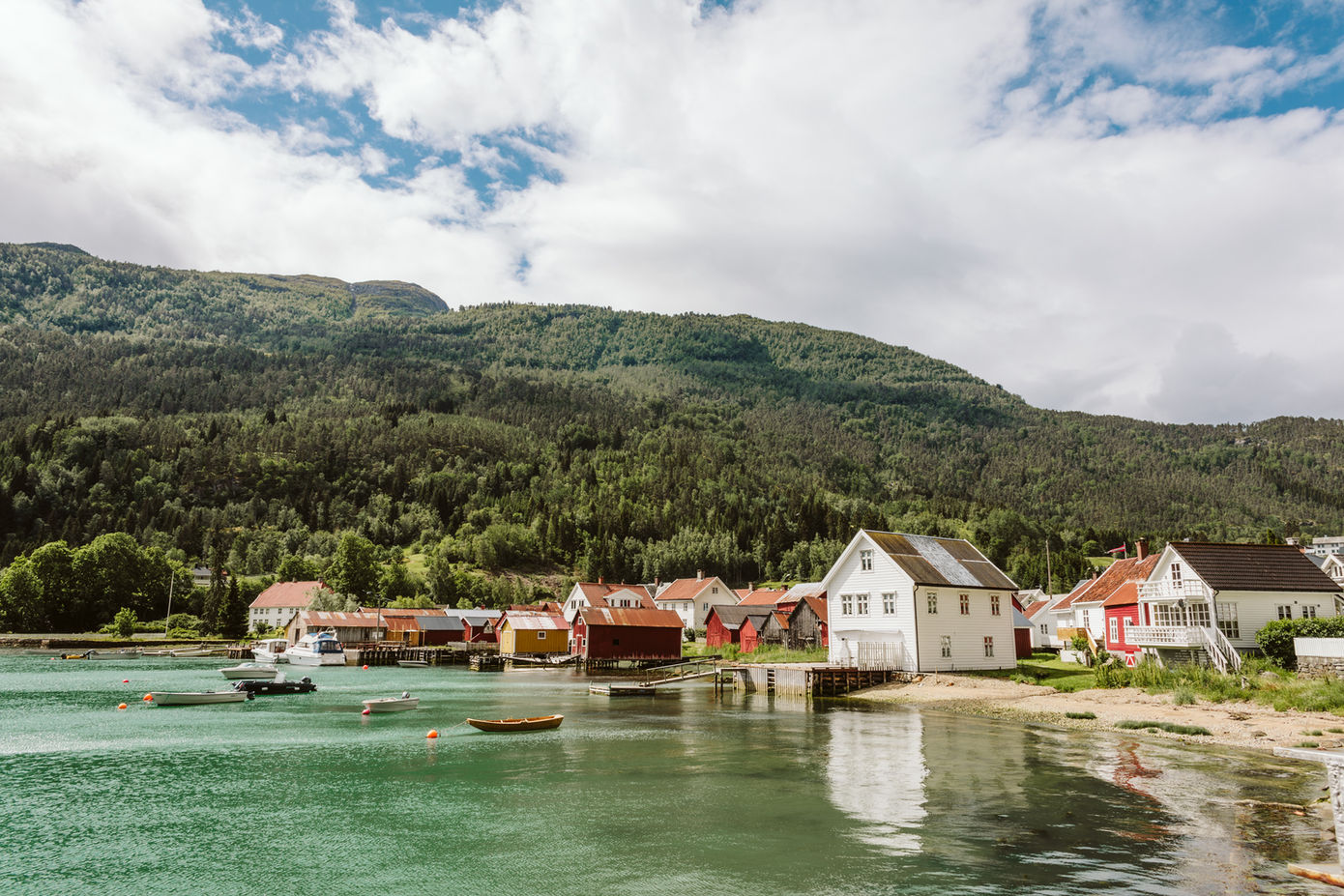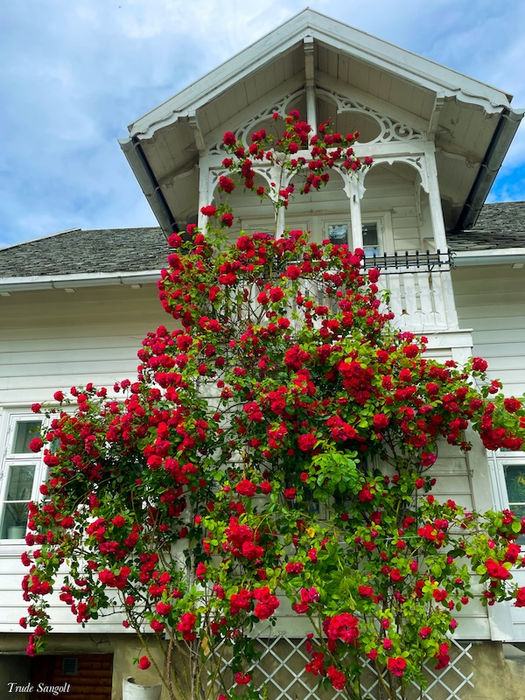
Solvorn
Village of Solvorn
Solvorn has about 220 inhabitants, a school, and a kindergarten, making it a lively village with many activities. In the summer, the village comes to life, with bustling streets and a lively beach scene. “Costa del Solvorn” unofficially boasts the warmest swimming temperatures in the Sognefjord.
Solvorn is one of the best-preserved coastal settlements from the 19th century. When the fjord was the main transportation route and steamships ran regular routes to Bergen, Solvorn had a thriving small-town atmosphere. There were general stores with bakeries, lamp shops, pharmacies, and shoemakers. The locals cultivated tobacco and even had their own post office and telegraph service. However, when cars became the primary mode of transportation in the 1950s, Solvorn was left off the main travel routes. Today, the village center is protected as a heritage site.
Solvorn has two dining options besides the hotel:
-
Kvitabui serves local food in a rustic setting. You can enjoy food and drinks in a renovated boathouse or on the pier with a view of the turquoise Lustrafjord. Kvitabui sources its own ingredients, including langoustines, venison, and locally caught white fish. The daily menu is fixed, offering simple dishes suitable for both lunch and dinner.
-
Bryggehuset is a small café located about 100 meters from the hotel, serving simple light meals.
Our good neighbor, Eplet Hostel and Apple Juice Farm, produces the best apple juice, which we serve for breakfast every day. We have no doubt that these exquisite drops can compete with bottles from the continent or the "New World"! At Eplet, you’ll also find a small shop selling juice and jam.
Another great neighbor, Villa Solvorn, offers charming and idyllic rooms with breakfast service.
Solvorn offers many marked hiking trails, maintained by the local village association. You can walk along the fjord or hike up into the hills to enjoy stunning views.
From the pier, you can take a small ferry across the fjord to Urnes Stave Church, dating back to the 1130s. Urnes is both the oldest and the most richly decorated of Norway’s 28 preserved stave churches.
Welcome to Solvorn!

"The boathouse that rests by the fjord in Solvorn begs for stories from a bygone era."
History of Solvorn
Excerpt from the brochure "Welcome to Solvorn – the Pearl by the Lustrafjord," written by Trond Henrik and Agnethe at Eplet Bed & Apple in Solvorn (edited 2022):
10,000 years ago, Norway was covered by a thick ice sheet. As the ice melted, a remnant of the glacier dammed up a lake at Hafslo. When the water pressure became too great, the ice burst, and the rushing water carved out two deep gorges at the top of Solvorn Valley. For thousands of years, the path up the western side of the steep Skormagjelet gorge was the easiest route from Hafslo and Veitastrond down to the Lustrafjord and the outside world.
By the 19th century, it became even more important to transport goods between Hafslo and the fjord, and in 1860, a carriage road was built. Today, this road is called “Gamlevegen” (the Old Road) and is a picturesque path with grass and black wrought-iron fences. The road was steep, and for horses pulling heavy carts, it was extremely dangerous. After several accidents, a new route was built.
The new road was completed in 1893 and has been expanded several times since then. It is said that the road was placed on the shady side of the valley to keep sleigh conditions as long as possible into the spring. Snow lingered longer in Hafslo and Veitastrond than in Solvorn. The road branches off from Highway 55 at Galden, 200 meters above sea level, and is three kilometers long. Through many bends, it leads you down to idyllic Solvorn, the pearl of the Lustrafjord.
Ancient History and Archaeology
Solvorn has an exceptionally good climate and fertile soil. It is believed that there were powerful farms here during the Viking Age. At the edge of the terrace at Kjelda, with a magnificent view of the fjord and the village below, lies a burial mound from the early Middle Ages. A fibula—a bronze brooch—was found in this grave, a common find in Viking-era burial sites, indicating that the deceased was a prominent woman. Across the road, excavations have revealed a large Iron Age farm.
With the arrival of Christianity, burial customs changed. Several historical figures, including members of the Munthe family from Kroken, are buried in the old churchyard. The first church in Solvorn was probably a stave church, but the Reformation required churches to have seating, and many older churches were too small and had to be demolished. The new wooden church, described as "a beautiful timber building," stood for over 300 years before being torn down in 1883. It was sold to an innkeeper for 420 kroner and now houses Galleri Walaker 300. The new church was completed the same year, and its tower was inaugurated by teacher Vigdal, who was also an avid mountaineer—he even climbed to the top of the church spire wearing wooden clogs!
Challenging Times and Agricultural Shifts
In the past, most people in Solvorn were tied to farming and depended on nature’s bounty. The climate worsened during the Little Ice Age in the 1700s, making life very difficult. On the Sjøthun farm, Lars Sørensen Rødberg erected a large stone in memory of the harsh winter of 1693 when farmers had to slaughter their livestock to survive. The stone is still known as Kjøtbogen (The Meat Rock) among locals.
There was once an abundance of fish in the Lustrafjord, and every autumn, fishermen from the coast came to catch sprat. Solvorn also had its own fishing cooperative. It is said that, at times in the 19th century, boats were so densely packed in the bay that one could walk across them without getting wet. A barrel factory stood outside Hamnen, producing herring barrels for fishermen—this building still stands today.
The Rise of Solvorn as an Administrative and Trade Center
Solvorn’s importance grew when the district judge moved from Sogndal to Solvorn in 1813. Eidsvoll delegate Irgens bought the old trading post Sanden and built Christianelyst, an estate in Empire style with five buildings. The main house had twenty rooms, making it one of the largest wooden houses in Western Norway in 1814. The property remains privately owned.
In addition to hay, grain, potatoes, vegetables, fruits, and berries, farmers in Solvorn also cultivated tobacco in the late 1800s. Many tobacco-drying houses were built during this period, but only two remain. One of these, near Vetlekaien (Little Quay), still has gaps between the planks to allow for quick drying of tobacco leaves. From Vetlekaien, also known as Jotunheimen’s Quay, boats traveled to Ornes and Kinsedal. For centuries, Solvorn served as a vital trade hub, shipping timber, firewood, cheese, butter, hides, and leather to Bergen, and returning with salt, tools, and urban goods.
Solvorn’s role as a marketplace was natural—farmers had to bring their goods here for transport out of the fjord and beyond. The village was home to shops, craftsmen, a sheriff, a post office, a telegraph station, a bank, an inn, and a courthouse.
Walaker Hotel and the Legacy of Hospitality
Across the bay, an inn has operated continuously since 1640. Walaker Hotel is Norway’s oldest hotel and has been run by the same family since 1690. Merchants from Bergen, travelers from Veitastrond, and locals would meet here for a beer and conversation. Today, Walaker Hotel remains in full operation and is a historic destination in its own right. It is part of De Historiske Hotellene (Norway’s Historic Hotels) and is open from April to October.
The old courthouse at Walaker housed Sogn og Fjordane’s first post office, established in 1841, followed later by a telegraph station. A new pier was built by Jacob Walaker in 1859, and from 1860, the steamship Framnes ran regular routes to Bergen. The pier in Solvorn became a meeting place for traveling merchants, locals visiting the district judge, and British tourists on fjord safaris. It was also the departure point for many young people from Solvorn who emigrated to America in the 19th century, as many villages in Western Norway had limited space and opportunities.
Solvorn’s Heritage and Preservation
Many poor people living along the shore were tenant farmers with contracts under local landowners. These "strandsitters" (coastal settlers) found economic opportunities in Solvorn through craftsmanship and temporary work. The village center became an administrative hub with a bustling small-town life. Solvorn had several general stores with bakeries, a lamp shop, a pharmacy, and a shoemaker.
Many merchants came from Bergen or other towns and settled in Solvorn to run businesses. They built Swiss-style houses in a straight row about 100 meters from the waterfront. One such house was built in 1879 by Johannes Vigdal, a legendary mountain guide and schoolmaster. In 1950, sheriff Hans Sjøthun built a new house on the same site, which has since been transformed into Eplet Bed & Apple guesthouse and juice factory.
Solvorn Today
From the 1950s, cars replaced boats as the main mode of transport. With new road networks, Solvorn was left off the main travel routes, becoming a scenic detour from Highway 55. This detour, however, helped preserve Solvorn as one of Norway’s best-kept coastal settlements from the late 1800s. Today, Solvorn’s center is protected and is part of the buffer zone for the UNESCO World Heritage Site on the other side of the Lustrafjord—Urnes Stave Church.
The MF Urnes car ferry (built in 1969) transports pedestrians, cyclists, and vehicles across the fjord to the stave church, often combined with a cycling trip along the "Romantic Road" along the southern shore of the Lustrafjord.
















